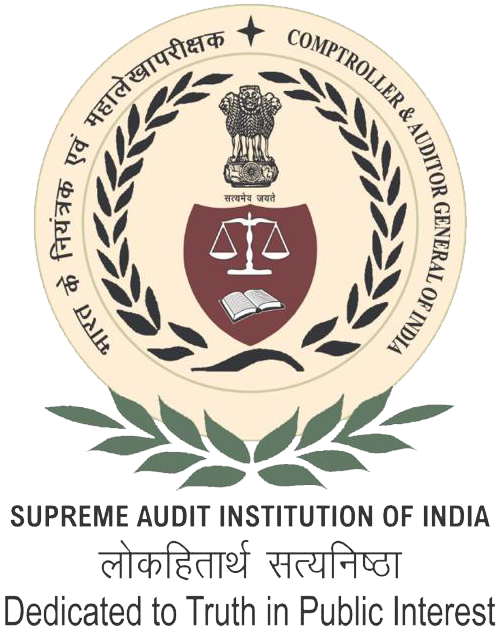Audit Reports

Maharashtra
Report No.1 of 2021 State Finance, Government of Maharashtra
Overview
State Finances Audit Report of the Comptroller and Auditor General of India for the year ended 31 March 2020 (Report No. 1 of the year 2021)
Key Words
- Preface
Governor of Maharashtra, Article 151 of the Constitution of India, Audit observations, Finance Accounts and Appropriation Accounts, 31 March 2020
2. Chapter- I Overview
Maharashtra, Population, General Category States (GCS), Compounded Annual Growth Rate (CAGR), GSDP, GDP, Sectoral contribution, Public Sector Undertakings (PSUs), Government Companies, Statutory Corporations, Turnover, Investment, Equity, Long-term loans, Budgetary Support, FRBM, MTFPS, Fiscal, Budget, Actuals, Tax, Deficit, Surplus
3. Chapter-II – Finances of the State
State Government, Fiscal aggregates, Resources, Receipts, GST, CGST, Tax Evasion, Central tax transfer, Financial Assistance, Finance Commission, FFC Grants, Local Bodies, Panchayati Raj, Pension, Interest, Subsidy, Investments, Return on Investment, Loans disbursed, Ongoing Projects, Historical cost, Present Value of Investment, Dividend, Interest Coverage Ratio, Debt Turnover Ratio, Consolidated Fund, Reserve Fund, Repayment, Debt Sustainability, Guarantees, Cash balance, Recommendations
4. Chapter-III - Budgetary Management
Budget, Budget Manual, Budget Estimates, Voted, Charged, Appropriation Accounts, Supplementary, Provision, Contingency Fund, Re-appropriation, Savings, Surrender, Excess expenditure, Grant-in-Aid, Lump sum Provisions, Projection, Flow of Expenditure, Review of selected Grants
5. Chapter-IV- Quality of Accounts and Financial Reporting Practices
Maharashtra Nivara Nidhi (MNN), Interest bearing deposits, Implementing Agencies, Utilisation Certificate, Grantee Institutions, Abstract Contingent Bills, Personal Deposit Accounts, Minor Head, Suspense and DDR heads, Adverse Balances, Reconciliation, Accounting Standards, Autonomous Bodies, Separate Audit Report, Proforma Accounts, Section 14, Misappropriations, losses, Follow up
Material for hoisting of Audit Reports on website of CAG
|
Date on which Report Tabled |
28 December 2021 |
|
Date of sending the Report to Government |
06 September 2021 |
|
Government Type |
State |
|
State |
Maharashtra |
|
Sector |
State Finance Audit Report |
|
Report Type |
Financial |
Overview on Report on State Finances for the year ended 31 March 2020
Maharashtra is the second largest State in India in terms of population (11.24 crore population as per 2011 census) and has geographical area of 3.08 lakh square kilometres (Sq. Km). The Gross State Domestic Product (GSDP) in 2019-20 at current prices was ₹ 28, 78,583 crore (advance estimates). The Compounded Annual Growth Rate (CAGR) of GSDP for the period 2011-12 to 2019-20 has been 10.66 per cent as against 11.98 per cent in the General Category States (GCS) of the country. The State’s literacy rate has increased from 76.9 per cent (census 2001) to 82.3 per cent (census 2011). The per capita income of the State stood at ₹ 2, 07,727 as against the country average of ₹ 1,35,050.
This Report on the Finances of the Government of Maharashtra is being brought out with a view to objectively assess the financial performance of the State during
2019-20 and to provide the State Government and State Legislature with timely inputs based on audit analysis of financial data. In order to give a perspective to the analysis, an effort has been made to compare the achievements with the targets envisaged by the State Government Fiscal Responsibility and Budgetary Management Act, 2005 and in the budget estimates of 2019-20.
Based on the audited accounts of the Government of Maharashtra for the year ended March 2020, this Report provides an analytical review of the Annual Accounts of the Government. The Report is structured in four Chapters.
Chapter 1 – Overview - This Chapter describes the basis and approach to the Report and the underlying data, provides an overview of structure of Government Accounts, budgetary processes, macro-fiscal analysis of key indices and State’s fiscal position including the deficits/surplus.
Chapter 2 – Finances of the State: This Chapter provides a broad perspective of the finances of the State, analyses the critical changes in major fiscal aggregates relative to the previous year, overall trends during the period from 2015-16 to 2019-20, debt profile of the State and key Public Account transactions, based on the Finance Accounts of the State.
Chapter 3 – Budgetary Management - This Chapter is based on the Appropriation Accounts of the State and reviews the appropriations and allocative priorities of the State Government. It reports on deviations from Constitutional provisions and highlight issues affecting transparency.
Chapter 4 – Quality of Accounts and Financial Reporting Practices - This Chapter provides an overview and status of compliance of the departments of the State Government with various financial rules, procedures and directions during the current year.
Download Audit Report
- Index Report No.1 of 2021 State Finance, Government of Maharashtra
- Preface of Report No.1 of 2021 State Finance, Government of Maharashtra
- Chapter 1 of Report No.1 of 2021 State Finance, Government of Maharashtra
- Chapter 2 of Report No.1 of 2021 State Finance, Government of Maharashtra
- Chapter 3 of Report No.1 of 2021 State Finance, Government of Maharashtra
- Chapter 4 of Report No.1 of 2021 State Finance, Government of Maharashtra
- Appendices of Report No.1 of 2021 State Finance, Government of Maharashtra

